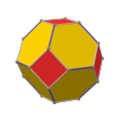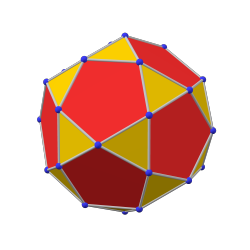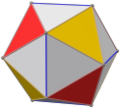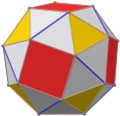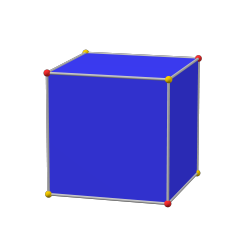Truncated icosahedron
| Truncated icosahedron | |
|---|---|
 | |
| Type | Archimedean solid Uniform polyhedron Goldberg polyhedron |
| Faces | 32 |
| Edges | 90 |
| Vertices | 60 |
| Symmetry group | Icosahedral symmetry |
| Dual polyhedron | Pentakis dodecahedron |
| Vertex figure | |
 | |
| Net | |
 | |

In geometry, the truncated icosahedron is a polyhedron that can be constructed by truncating all of the regular icosahedron's vertices. Intuitively, it may be regarded as footballs (or soccer balls) that are typically patterned with white hexagons and black pentagons. It can be found in the application of geodesic dome structures such as those whose architecture Buckminster Fuller pioneered are often based on this structure. It is an example of an Archimedean solid, as well as a Goldberg polyhedron.
Construction
The truncated icosahedron can be constructed from a regular icosahedron by cutting off all of its vertices, known as truncation. Each of the 12 vertices at the one-third mark of each edge creates 12 pentagonal faces and transforms the original 20 triangle faces into regular hexagons.[1] Therefore, the resulting polyhedron has 32 faces, 90 edges, and 60 vertices.[2] A Goldberg polyhedron is one whose faces are 12 pentagons and some multiple of 10 hexagons. There are three classes of Goldberg polyhedron, one of them is constructed by truncating all vertices repeatedly, and the truncated icosahedron is one of them, denoted as .[3]
Properties
The surface area and the volume of the truncated icosahedron of edge length are:[2] The sphericity of a polyhedron describes how closely a polyhedron resembles a sphere. It can be defined as the ratio of the surface area of a sphere with the same volume to the polyhedron's surface area, from which the value is between 0 and 1. In the case of a truncated icosahedron, it is:[2]
The dihedral angle of a truncated icosahedron between adjacent hexagonal faces is approximately 138.18°, and that between pentagon-to-hexagon is approximately 142.6°.[4]
The truncated icosahedron is an
Truncated icosahedral graph

According to
Appearance

The balls used in
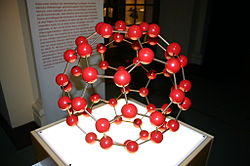

The truncated icosahedron was known to
See also
- Chamfered dodecahedron
- Icosahedral twins - Nanoparticles which can have the shape of a truncated icosahedron
References
- ISBN 978-0-691-22534-0.
- ^ MR 0290245.
- ISBN 978-0-387-92713-8.
- Zbl 0132.14603.
- ISBN 978-3-319-64123-2.
- ^ Koca, M.; Koca, N. O. (2013). "Coxeter groups, quaternions, symmetries of polyhedra and 4D polytopes". Mathematical Physics: Proceedings of the 13th Regional Conference, Antalya, Turkey, 27–31 October 2010. World Scientific. p. 48.
- ISBN 978-0-521-55432-9.
- ISBN 978-0-486-23729-9.
- ISBN 9780486268514.
- ISBN 978-3-319-30451-9.
- ^ Read, R. C.; Wilson, R. J. (1998). An Atlas of Graphs. Oxford University Press. p. 268.
- ^ Godsil, C.; Royle, G. (2001). Algebraic Graph Theory. New York: Springer-Verlag. p. 211.
- ^ a b Kostant, B. (1995). "The Graph of the Truncated Icosahedron and the Last Letter of Galois" (PDF). Notices of the American Mathematical Society. 42 (9): 959–968.
- .
- ISBN 978-1-4504-9679-7.
- ISBN 9789811237126.
- ISBN 978-0-444-52844-5.
- ISBN 0-684-82414-0.
- ^ Katz, Eugene A. (2011). "Bridges between mathematics, natural sciences, architecture and art: case of fullerenes". Art, Science, and Technology: Interaction Between Three Cultures, Proceedings of the First International Conference. pp. 60–71.
- S2CID 118516740.
External links
- Weisstein, Eric W., "Truncated icosahedron" ("Archimedean solid") at MathWorld.
- Klitzing, Richard. "3D convex uniform polyhedra x3x5o - ti".
- Editable printable net of a truncated icosahedron with interactive 3D view
- The Uniform Polyhedra
- "Virtual Reality Polyhedra"—The Encyclopedia of Polyhedra
- 3D paper data visualization World Cup ball













